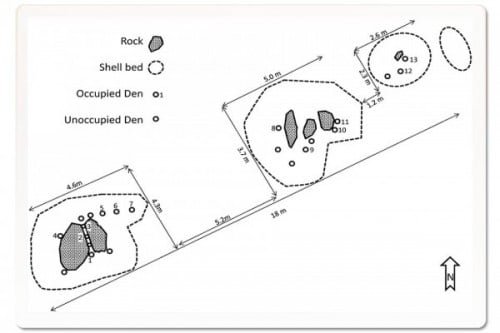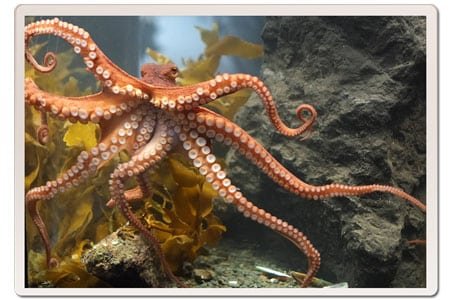Welcome back to my review of last years oceanic changes and trends – part 2: New Discoveries! In part one, we considered tropical storms, the single-use plastic epidemic, and the impact of global warming on the world’s coral reefs. While all of these topics are important, they can be a bit depressing, which fortunately isn’t the case for the entirety of this entry! Read on to learn about some fascinating new inventions and discoveries that scientists made in 2017, including a few new species and even whole new animal civilizations that were formed right beneath our noses!
One such type of civilization that we didn’t know existed until so recently is the concept of octopus cities! For the longest time, scientists believed octopus were solitary creatures, only meeting up with others to mate. This was proven wrong in 2017, when not one but two different civilizations of Octopus were discovered. Dubbed “Octlantis” (mapped below) and “Octopolis”, these octopus-made cities consisted of a collection of dens nestled together among shells and other junk the animals had scavenged in the area. While this behavior seems to be derived from a social cue, scientists think that the area was initially a naturally productive area for scallops, a favorite food for the octopus that leads to multiple octopuses building dens in a small area, which scientists believed lead to a social circle being formed over a period of time. With so many octopuses living in such a close area, the potential for high predation was there, however it wasn’t observed while the scientists were studying these unique cities. This finding goes to show how just how little we know about the oceans, where entire civilizations could be hiding right under our noses. Who knows what else we’ve been missing?!?!
With one amazing discovery of the happiest proportions, comes one that is a bit more humbling. Both the North Atlantic Right Whales and Vaquita porpoises experienced a continuing decline in populations during 2017. With only an estimated 100 breeding females left of the Right Whale species and only 30 individual Vaquita porpoises remaining on the planet in total, it is surely only a matter of time until these two species join the list of extinct species. But….while the odds look tough, especially for the Vaquita, they aren’t gone yet! Scientists are working tirelessly to provide as much protection for these animals and are working on ways to try and increase their populations. Both species have been negatively impacted due to human causes, with numbers declining mostly due to ship strikes and fishing gear entanglement. Therefore, if we can lower such impacts on these species, then they still stand a chance of surviving, along with some special help from our keen-minded scientists!
2017 was also a big growth year in terms of human inventions based on the physical characteristics of animal. However, acknowledging the magnificence of the animal kingdom and trying to mimic its many ingenious designs isn’t a new revelation. In past years, inventors have manufactured more efficient fan blades for collecting wind energy based on whale flippers, while others have designed new car panels that are stronger yet lighter than ever before, based on the design of a bill of the Toucan! Furthermore, underwater adhesives were created, with researchers hoping to mimic the method in which a remora is able to attach itself to its bigger counterparts. Not only that, but Tuna’s ability to quickly turn due to its ability to raise and lower small fins on the top and bottom of its body has lead scientists to investigate a way to allow future robots to swim! These continuing studies just go to show that humans as a species have so much to learn from all the other animal species on this magnificent planet; all we need to do is open our eyes and listen!
While the previous points are very interesting in their own regard, the fact that researchers are continually discovering new species every year is also remarkable, with 2017 being no different. Last year saw the revelation that instead of the previously believed three species of sunfish residing in our oceans, it was determined that there is in fact 4 species, with Mola tecta being officially confirmed as the additional genus. The word tectus in Latin translates to hidden, which just goes to show you that scientists can have a sense of humour too! Additionally, a new species of surgeonfish was discovered in the Philippines. This particular species of fish (Acanthurus albimento) has a bright orange face, with iridescent blue streaks located on its body. This was a surprise to the scientific community as the Philippines has been a site of surgeonfish research for many years, yet this new discovery was made at the heart of the existing study area!

Apparently, humans have much left to learn, which is what makes this upcoming year so exciting. Who knows what could be swimming along (or in hiding!) waiting to be discovered at this very moment?!

